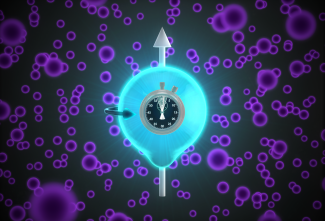In a new paper published in Physical Review Letters, JILA and NIST Fellows Eric Cornell, Jun Ye, and Konrad Lehnert developed a method for measuring a potential dark matter candidate, known as an axion-like particle. Axion-like particles are a potential class of dark matter particle which could explain some aspects of galactic structure. This work is also a result of collaboration with Victor Flambaum who is a leading theorist studying possible violations of fundamental symmetries.
The microscopic nature of dark matter has been a looming question within physics for decades. According to first author Tanya Roussy: "Dark matter is one of the biggest unsolved mysteries in modern physics. And the problem is that it could be anything. We don't know what it is." Dark matter is a tricky thing to study---so far, the only way to detect its presence is through its gravitational signatures in astrophysical measurements. Being able to detect dark matter through its couplings to earth-bound ordinary matter or fields would allow physicists to better understand the particle nature of dark matter, which is essential for understanding the majority of matter in our universe.
How to Find Something Invisible
Searching for the nature of dark matter wasn't straightforward or easy. Roussy explained: "You kind of have to look everywhere, which is really hard. If we had some kind of guess for what it might be, we could narrow our search and maybe find it. So being able to do searches over a really big parameter space is really important right now. In the case of dark matter, we consider mass. So, there's 40 orders of magnitude that the mass could be in. And that's really, really big. So being able to search over something like seven orders of magnitude is a nice way to put a dent in that search."
When trying to measure an elusive particle, sensitivity is key. JILA’s team leveraged a very sensitive measurement they already had to look for signatures of their dark matter candidate: their ongoing electron electric dipole moment measurement (eEDM). JILA fellow Konrad Lehnert noted that "the main significance of this paper is that the Cornell and Ye group experiment that tries to measure EDM would also be sensitive to axion-like particles." If the dark matter in our universe was actually made up of axion-like particles, things like the eEDM would actually “wiggle” in time as the dark matter waves passed by them, like a rubber duck bobbing on the waves in a bathtub. According to Roussy: "We took an old data set and reanalyzed it…until now we always assumed our signal was constant in time. Instead we said, 'what if it actually wiggles in time?' So, we were basically checking for a wiggle in the signal." Lehnert’s group had experience in other axion search experiments and assisted with the data analysis.
This collaboration allowed the team to develop a set of protocols for using eEDMs to detect axion-like particles. "What we did was put together a recipe that other people can use to do these kinds of searches on their own, if they have sensitive measurements of this sort." Roussy commented. "We think this is better than many other recipes that are out there because it solves some problems that people have been ignoring until now." These protocols will hopefully assist other labs in searching for the nature of dark matter, and advance scientific knowledge about dark matter in a more efficient way.
This work was supported by the Marsico Foundation, NIST, and the NSF.
Written by Kenna Castleberry, Science Communicator at JILA



 The Physics Frontiers Centers (PFC) program supports university-based centers and institutes where the collective efforts of a larger group of individuals can enable transformational advances in the most promising research areas. The program is designed to foster major breakthroughs at the intellectual frontiers of physics by providing needed resources such as combinations of talents, skills, disciplines, and/or specialized infrastructure, not usually available to individual investigators or small groups, in an environment in which the collective efforts of the larger group can be shown to be seminal to promoting significant progress in the science and the education of students. PFCs also include creative, substantive activities aimed at enhancing education, broadening participation of traditionally underrepresented groups, and outreach to the scientific community and general public.
The Physics Frontiers Centers (PFC) program supports university-based centers and institutes where the collective efforts of a larger group of individuals can enable transformational advances in the most promising research areas. The program is designed to foster major breakthroughs at the intellectual frontiers of physics by providing needed resources such as combinations of talents, skills, disciplines, and/or specialized infrastructure, not usually available to individual investigators or small groups, in an environment in which the collective efforts of the larger group can be shown to be seminal to promoting significant progress in the science and the education of students. PFCs also include creative, substantive activities aimed at enhancing education, broadening participation of traditionally underrepresented groups, and outreach to the scientific community and general public.